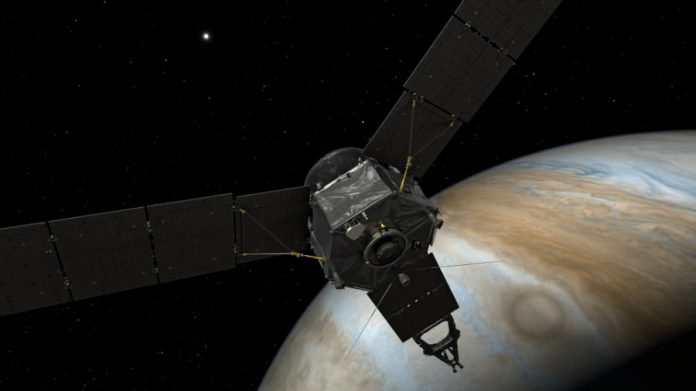
NASA’s Juno spacecraft will get a first close look at Jupiter this Saturday. At 8.51 EDT on August 27, Juno will zoom closer than ever before, within 2,600 miles (4,000 kilometers) of the planet’s cloud tops.
Juno principal investigator Scott Bolton said the spacecraft would have all of its science instruments available, contrary to its first arrival into Jupiter’s orbit on July 4th. Back then, NASA turned Juno’s instruments off to focus on the rocket propulsion to reach the orbit.
The spacecraft is ready with eight tools to capture all important details, including the JunoCam, a high-resolution visible light image to snap pictures of the Jovian atmosphere and the first peak of Jupiter’s north and south poles.
However, NASA’s official statement explained that Saturday’s data would take days to reach the Earth, and the institution expects the images around September 3.
NASA hopes research from Juno is essential to understand the Solar System
Juno is a $1.1 billion dollar mission that started on August 11. The launch was in Cape Canaveral, Florida as a part of NASA’s New Frontiers Program.
Juno has the mission of mapping the King of Planet’s magnetic and gravitational fields to help the understanding of its infrastructure, composition, and functionality. NASA thinks the evolution of Jupiter might hold the answer about the origins of the Solar System.

The probe should finally discover whether the massive plane has a solid core or if it is purely gas that is denser and more compressed all the way to the center of the planet Scientists do know that the planet’s composition is similar to a star. It’s made mostly of hand helium.
Science could also gain some perspective about the famous Great Red Spot, the colossal storm vortex – twice the size of the Earth – that has ever raged Jupiter’s atmosphere. Juno will finally tell how far back it goes.
Juno arrived at Jupiter’s orbit on July 4th after five years of space traveling
That day, the probe became gravitationally bound to the planet’s orbit, 2.8-billion km away from Earth. With a careful engine burn, the probe entered in a large ellipse around the globe that take 53 days to travel. As of now, Juno is flying at 130,000 mph (208,000 kph).
Jupiter is 11 times wider than Earth and 300 times as big; the planet takes 12 Earth years to orbit the Sun, while “a day” last 10 hours.
There are 35 more close flybys inside Jupiter’s orbit in the ship’s core mission. The mission is scheduled to end in February 2018. Then, the probe will have a heroic death as it will be commanded to make a destructive drive into Jupiter’s atmosphere.
Source: NASA











